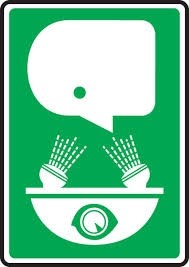Laboratory Eyewash Safety Shower Requirements

Laboratory students and scientists usually wear safety glasses to protect their eyes, in addition to wearing lab coats to protect most of their body. When handling corrosive or dangerous chemicals, these safety precautions may not be enough. Laboratory eye wash stations and safety showers provide emergency care when dangerous chemicals get on the body or in the eyes. In the U.S., the Occupational Safety and Health Administration (OSHA) requires laboratory eye wash and safety shower stations, while the American National Standards Institute (ANSI) sets the standards for installation and inspection.
Emergency Showers
All laboratories which utilize corrosive chemicals must provide emergency showers for their employees, according to OSHA. ANSI regulations require showerheads to be 82 inches to 96 inches above the floor of the shower stall. In addition, the shower stall must be self-contained. The spray of the showerhead must be 20 inches in diameter. Laboratory safety showers must draw 20 gallons per minute at 30 pounds of pressure per square inch for a minimum of 15 minutes. Safety shower valves must be easy to operate and activate the shower in under a second. The fluid used for washing off corrosive or dangerous chemicals should be warm.
Eyewash Equipment
Eyewash equipment helps flush out the eyes if caustic or corrosive chemicals touch the eyeball or eyelids. Eyewash equipment should be made of materials that resist corrosion. The equipment's flow should be low enough so that it doesn't damage the eye. The nozzles of the eyewash should be between 33 and 45 inches from the floor. Nozzles must be located six inches from the wall. In addition, temperature gauge equipment should be used to ensure that the liquid is warm. Eyewash safety equipment should have a flow of at least 0.4 gallons per minute at thirty pounds per square inch for 15 minutes of operation. The station should have an easily located button or floor lever which can be used to activate the unit.
Location
Laboratory emergency eyewash and shower stations should be located within a 10 second walk or 55 feet from lab workers. The path to these emergency stations shall be unobstructed and clear of any trip hazards. ANSI requires all employees to be made aware of safety equipment and how to operate equipment in case of an emergency.
Inspection
All lab eyewash stations and safety showers must be inspected annually by an ANSI-certified company. The inspector will conduct a thorough examination of all equipment to ensure that it is functioning properly. Emergency showers and eyewash stations should be tested for proper functioning at least once a week by a designated person working at the laboratory. Testers should check plumbing and ensure that water pressure and the temperature of fluids from the unit are within normal ranges.
Emergency Showers
All laboratories which utilize corrosive chemicals must provide emergency showers for their employees, according to OSHA. ANSI regulations require showerheads to be 82 inches to 96 inches above the floor of the shower stall. In addition, the shower stall must be self-contained. The spray of the showerhead must be 20 inches in diameter. Laboratory safety showers must draw 20 gallons per minute at 30 pounds of pressure per square inch for a minimum of 15 minutes. Safety shower valves must be easy to operate and activate the shower in under a second. The fluid used for washing off corrosive or dangerous chemicals should be warm.
Eyewash Equipment
Eyewash equipment helps flush out the eyes if caustic or corrosive chemicals touch the eyeball or eyelids. Eyewash equipment should be made of materials that resist corrosion. The equipment's flow should be low enough so that it doesn't damage the eye. The nozzles of the eyewash should be between 33 and 45 inches from the floor. Nozzles must be located six inches from the wall. In addition, temperature gauge equipment should be used to ensure that the liquid is warm. Eyewash safety equipment should have a flow of at least 0.4 gallons per minute at thirty pounds per square inch for 15 minutes of operation. The station should have an easily located button or floor lever which can be used to activate the unit.
Location
Laboratory emergency eyewash and shower stations should be located within a 10 second walk or 55 feet from lab workers. The path to these emergency stations shall be unobstructed and clear of any trip hazards. ANSI requires all employees to be made aware of safety equipment and how to operate equipment in case of an emergency.
Inspection
All lab eyewash stations and safety showers must be inspected annually by an ANSI-certified company. The inspector will conduct a thorough examination of all equipment to ensure that it is functioning properly. Emergency showers and eyewash stations should be tested for proper functioning at least once a week by a designated person working at the laboratory. Testers should check plumbing and ensure that water pressure and the temperature of fluids from the unit are within normal ranges.
- rtbba903b56f0e78afc32cc8b6842ff5b7.jpg